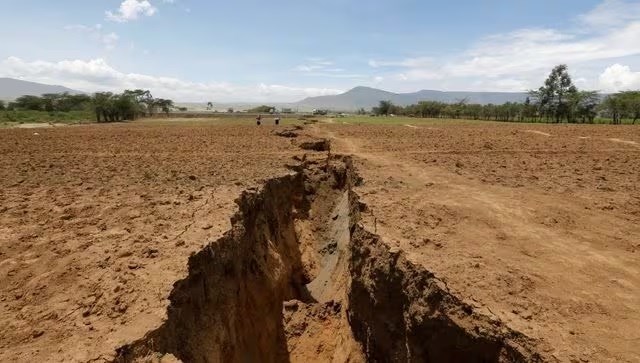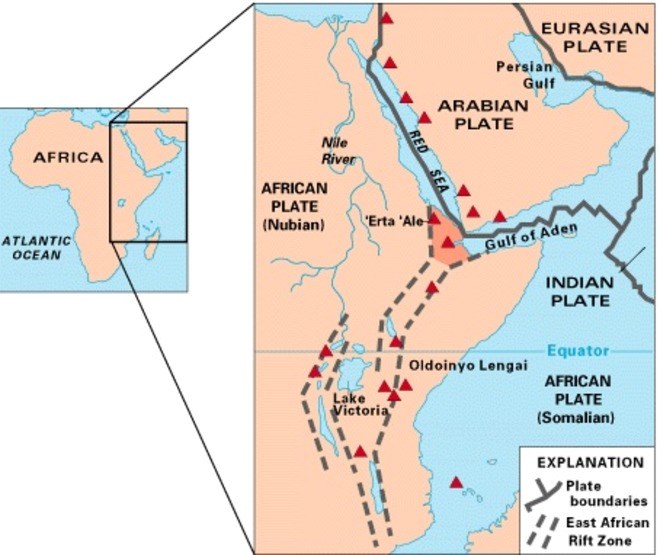The Big Break-up: How Africa is gradually splitting into two continents and giving rise to a new ocean

Source: FIRSTPOST, Sunday March 12, 2023
Scientists say Africa is peeling apart into two parts that will eventually lead to the formation of a new ocean. While the process will take millions of years to complete, this will split present-day Somalia and parts of Kenya, Ethiopia, and Tanzania from the rest of the continent, as per reports

The new ocean, splitting Africa into two continents, will take at least 5 to 10 million years to form. Reuters (Representational Image)
Africa is breaking up or “rifting” into two parts and a new ocean is being born, scientists have said.
As per a research published in the peer-reviewed journal Geophysical Research Letters, two major sections of the continent are peeling apart, which could eventually form a new ocean.
Let’s understand the reason behind the split and how long will it take for Africa to break up.
What is rifting?
According to Science Direct, rifting is the tearing apart of a “single tectonic plate into two or more tectonic plates separated by divergent plate boundaries”.
A lowland region called the rift valley erupts where Earth’s tectonic plates move apart, noted National Geographic. These rift valleys can occur on land as well as at the bottom of the ocean.
This phenomenon can be dated at least 138 million years back when South America and Africa were divided into different continents, says IFLScience report.
For the last 30 million years, the Arabian plate has been drifting away from Africa, a process that resulted in the creation of the Red Sea and the Gulf of Aden, according to NBC News.
Why is Africa is splitting into two?
The splitting up of the continent is linked to East African Rift, a 56 kilometres or 35-mile-long crack that emerged in Ethiopia’s desert in 2005. This will set off the formation of a new sea, as per a report in Economic Times.
The seismic data present in the research shows that the creation of the rift was triggered by similar tectonic processes that are taking place at the bottom of the ocean.
The crack was discovered at the border of three tectonic plates – African Nubian, African Somali, and Arabian – that have already been separating for some time, the Economic Times report added.
Spanning over 3,000km, the East African Rift Valley lies from the Gulf of Aden in the north towards Zimbabwe in the south. As per The Conversation, it divides the African plate into two parts: the Somali and Nubian plates.
“This is the only place on Earth where you can study how a continental rift becomes an oceanic rift,” Christopher Moore, a doctorate student at the University of Leeds, said, according to Mashable.
As rifting occurs, material from “deep inside Earth moves to the surface and forms oceanic crust at the ridges”, as per NBC News.
“We can see that oceanic crust is starting to form, because it’s distinctly different from continental crust in its composition and density,” Moore, who has been using satellite radar to monitor volcanic activity in East Africa that is associated with the continent’s breakup, had told NBC News in 2018.

How long before Africa is divided?
Not anytime soon.
It will take millions of years for Africa to be sliced into two unequal parts. The new ocean will take at least 5 million to 10 million years to form which could eventually give the landlocked countries of Uganda and Zambia their own coastlines.
The smaller continent created by the rift will include countries such as present-day Somalia and parts of Kenya, Ethiopia, and Tanzania, as per USA Today.
GPS tracking has revealed the different paces at which the land movements between these tectonic plates are occurring, with the Arabian plate shifting away from Africa at a rate of one inch per year.
“As we get more and more measurements for GPS, we can get a much greater sense of what’s going on,” Ken Macdonald, a marine geophysicist and a professor emeritus at the University of California, said, as per Mashable.
“The Gulf of Aden and the Red Sea will flood in over the Afar region and into the East African Rift Valley and become a new ocean, and that part of East Africa will become its own separate small continent.”
Dr Edwin Dindi of the Department of Geology in the Faculty of Science and Technology at the University of Nairobi told All Africa, “The Eastern arm of the Rift Valley is fairly active, this is seen in the many tremors that occur around it”. He added that “it will however take a long time probably millions of years” for the continent to split.
Though the process of rifting is happening for some time, the potential split made the headlines worldwide when a large crack in Kenyan Rift Valley emerged in 2018.
However, The Guardian reported then that the massive split was caused by sudden erosion rather than being evidence of the African continent actively tearing into two.
With inputs from agencies
